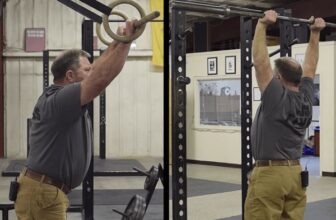
[adinserter block=”2″]
The Deadlift: Pushing the Floor
by Mark Rippetoe | August 09, 2023
The deadlift involves more
than just pulling the bar off the floor. It is not an idiot’s lift,
although you might get that impression at a powerlifting meet. The
mechanics of pulling the bar off the floor are not immediately
apparent, and were not actually described in detail until the
publication of Starting Strength: Basic
Barbell Training 3rd
edition in 2011. The short version is that
the bar must come off the floor in a straight vertical line over the
middle of the foot, with the shoulders a little forward of the bar.
The “why” is explained in detail in the book.
The “how” is the
perhaps-not-obvious part. High school “powerlifting coaches”
yelling “JUST PULL IT OFF THE FLOOR!!!” in their best Macho Man
Randy Savage voice do not actually get the job done. “Pulling”
the bar off the floor is the wrong approach to generating the
straight vertical line over the mid-foot that efficient mechanics
demands, as we shall see.
The mid-foot position of
the bar is not negotiable – a limit
deadlift cannot be pulled to lockout if the bar is forward of this
point, whereas a lighter deadlift can obviously be pulled
inefficiently. When you take a stance with the bar directly over the
mid-foot, take your grip on the bar, and prepare to pull, your knees
must travel forward a short distance to close the gap between your
shins and the bar on the floor. In the process of assuming this
position, if your hips drop more than just a little, your knees will
drop forward and the shins will move the bar forward of the mid-foot
start position. Ass bone’s connected to the … knee bone, knee
bone’s connected to the … shin bone.
Likewise, if the shins are
perfectly vertical and your hips are higher than a deadlift, like in
a stiff-leg deadlift, your shoulders are too forward and the bar can
swing forward of mid-foot because the lats can’t do their job. Lats
pull back on the upper arms, and their function in a pull is to keep
the bar over the mid-foot. The most efficient angle for them to pull
against the humerus is 90 degrees. If your setup position is correct,
lats will be at 90 degrees to the humerus and the shins will block
the bar in a perfect mid-foot/vertical alignment. If your ass is too
high, the lat angle on the arm is more than 90 degrees and the bar
can’t be controlled.
The geometry is simple:
hips too low, knees and shins push the bar forward – hips too high,
shoulders too forward, the bar swings forward – hips correct,
bar is over the mid-foot in contact with the shins, lats keep it
there as the bar comes off the floor. But if the bar goes forward of
mid-foot at limit weights, you miss the pull.
So here’s the point of
this dissertation: if the bar is going to come off the floor in a
vertical path, and if the shins are inclined forward of vertical, the
shins will have to become more vertical as the bar leaves the floor.
And this
is accomplished by actively extending the knees as the first motion
you think about. The best cue for this
movement is “Push the floor away from the bar.” You actually push
the middle of your foot down into the floor, like a leg press, but
where the hips move up instead of the foot plate. This extends the
knees and pulls them out of the way as the bar rides up the shins.
Thinking about “pulling
the bar off the floor” often results in the opposite of an
efficient pull. It usually looks like the lifter is attempting to
extend hips first,
instead of knees. If hips extend before knees, the knees remain
forward of the bar and the bar path will have to go forward around
the knees – this can actually happen at warmup weights. At limit
weights, the knees have to move back because the mid-foot position is
The Law, so the position sorts itself out at the expense of
inefficiency. But if you start the bar straight up by pushing the
floor straight down, you save time, energy, and aggravation.
It also gives you a way to
think about the start off the floor by actively involving the quads
while they’re still in a position to contribute to the work. The
start position of the deadlift shows an already extended knee angle
and a fairly closed hip angle, meaning that most of the actual work
of moving the bar will involve hip extension and isometric control of
the back position – quads don’t really have much to do. But if you
can consciously tell them to start the movement off the floor by
pushing the floor away, it’s a much more efficient use of your brain
and your quads. “JUST PULL IT OFF THE FLOOR!!!” doesn’t really
tell you how to get it
off the floor. Something precise to think about when the bar is heavy
is always useful.
Discuss in Forums
[adinserter block=”2″]
Credit : Source Post






